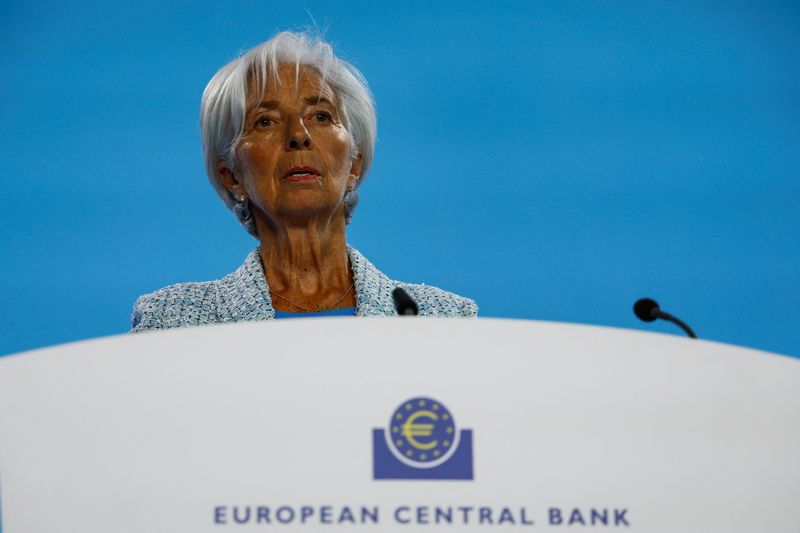(This June 6 story has been refiled to correct the spelling of Sabrina Khanniche's name in paragraphs 6 and 7)
By Yoruk Bahceli and Naomi Rovnick
LONDON (Reuters) - Traders scaled back bets that the ECB would cut interest rates twice more this year, and outpace peers in easing policy, after the euro zone central bank gave little hint on Thursday of further moves.
The European Central Bank lowered its key rate by 25 basis points (bps) from a record high to 3.75% at its policy meeting on Thursday, its first cut in five years. However, it raised its inflation forecasts and President Christine Lagarde declined at a press conference to confirm it had entered a phase of 'dialling back' its restrictive monetary policy.
That led traders to price in just 36 bps of further rate cuts this year -- meaning another cut and less than a 50% chance of a third to follow, compared with over a 60% chance earlier on Thursday.
When the ECB last met in April, traders were much more certain on a third cut.
The odds of a second cut by September fell to less than 70% from nearly 80% before Thursday's decision.
"If we'd had more visibility about the cutting cycle it would have been perceived more positively but there is still uncertainty," said Sabrina Khanniche, senior economist at Pictet Asset Management.
"Lagarde did not want to commit on the future path ahead," Khanniche said.
SHIFTING DIVERGENCE
The bank's hawkish tone added fuel to a shift in the economic divergence theme, with receding ECB rate cut bets contrasting with a renewed increase in U.S. rate cut expectations.
Earlier this year, the U.S. economy's stronger performance against the euro zone had driven investor preference for the bloc's debt and hurt the euro.
Since then, the bloc's economy grew more than expected during the first quarter after a recession late last year. The United States in contrast grew at less than half the rate it posted in the fourth quarter.
While traders have become less convinced on the scope for ECB rate cuts, they have increased bets on Federal Reserve easing, now expecting nearly 50 bps, or two cuts, this year, up from less than 35 bps a week ago.
The odds of a September Fed cut are now seen higher than one from the ECB.
"What we may now be seeing, if the data turns a little bit more in the U.S. and the Fed can go ahead with a cut in September, that may be the saving grace for the ECB (to cut in) September," said Soeren Radde, head of European economic research at hedge fund Point72.
That shifting outlook means government bonds in the euro zone will continue to lag, after they underperformed U.S. Treasuries for the first time since January last month, losing 0.2%, while U.S. Treasuries gained 1.5% .
Euro zone bonds have lost investors 1.2% year-to-date, double the 0.6% loss on U.S. Treasuries.
"The potential return you have from when you buy core and semi-core euro zone sovereign bonds is limited. Many investors have been reluctant to go in and buy," said Camille de Courcel, head of G10 rates strategy for Europe at BNP Paribas (OTC:BNPQY).
And in June so far, Germany's 10-year yield, the euro area benchmark, has dropped 10 basis points, half the 20 bps drop in U.S. peers. Bond yields move inversely with prices.
Roman Gaiser, head of fixed income for EMEA at Columbia Threadneedle, said he did not see gains ahead for euro zone government debt.
"We're not piling in," he added.
Prospects for fewer ECB cuts is better news for the euro. It edged higher on Thursday to $1.0883, adding to its roughly 2% rally from a five-month low hit in mid-April.
JPMorgan Private Bank's head of global FX strategy Samuel Zief sees a fair value of around $1.10 -- implying another 1% of gains.
The euro zone's improving economic performance means European stocks are also seen gaining. While underperforming U.S. peers, they have rallied over 9% this year and touched record highs earlier on Thursday.
European equities are "the main overweight we have in our global equity funds," said Kevin Thozet, investment committee member at asset manager Carmignac, adding the euro zone economy is in a "sweet spot".
Still, the shadow of the U.S. economy and Fed policy loom large over global markets, and that's no different for the euro zone.
Point72's Radde said he would have expected a further scaling back of traders' ECB rate cut expectations after Thursday's policy meeting had it not been for a softening U.S. economy.

"Lagarde was striving to argue (on Thursday) why they are not committing a policy mistake in cutting rates today," Radde said.
"That should have elicited quite a strong reappraisal of the rate outlook, and the fact that it didn't means there's a strong overlay from outside the euro area."